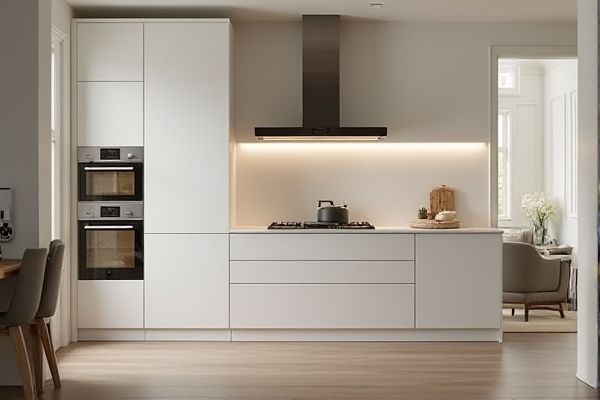
Soft-close cabinets feature specialized hinges that prevent doors from slamming shut, reducing noise and extending the lifespan of your cabinetry compared to standard cabinets that close abruptly. Discover how choosing the right cabinet type can enhance your kitchen's functionality and aesthetics by reading the rest of the article.
Table of Comparison
| Feature | Soft-Close Cabinet | Standard Cabinet |
|---|---|---|
| Closing Mechanism | Slow, controlled, silent close | Manual, quick, often noisy close |
| Durability | Reduced wear and tear; longer lifespan | More prone to damage over time |
| Safety | Prevents finger pinches and slam injuries | Risk of finger pinching and slamming |
| Price | Higher upfront cost | Lower initial cost |
| Maintenance | Minimal; hydraulic dampers may need replacement | Low; occasional hinge adjustment |
| Noise Level | Quiet and smooth operation | Loud closing noise |
| Installation | May require professional installation | Simple DIY installation |
Understanding Soft-Close Cabinets
Soft-close cabinets feature specialized hinges or drawer slides that control the closing speed, preventing slamming and reducing wear. These mechanisms use hydraulic dampers or spring systems to ensure a smooth, quiet shutdown, enhancing durability and user experience. Compared to standard cabinets, soft-close options improve safety and maintain cabinet integrity over time.
What Are Standard Cabinets?
Standard cabinets feature traditional hinges and hardware that allow doors and drawers to close with a simple push or pull, often resulting in louder slamming noises. These cabinets are typically less expensive and easier to install than soft-close models, making them popular in budget-conscious kitchen or bathroom renovations. While functional, standard cabinets lack the noise-reduction and gentle closing mechanisms found in soft-close variants, which can prevent wear and tear over time.
Key Differences: Soft-Close vs Standard Cabinets
Soft-close cabinets feature hydraulic hinges and dampers that prevent doors from slamming, offering quieter operation and reduced wear. Standard cabinets typically use traditional hinges without damping mechanisms, causing doors to close more abruptly and potentially leading to noise and damage over time. The soft-close mechanism enhances durability and convenience, making it a preferred choice in modern kitchen and bathroom cabinetry.
Pros and Cons of Soft-Close Cabinets
Soft-close cabinets offer the advantage of noise reduction and enhanced durability by preventing slam damage, making them ideal for maintaining a quiet and long-lasting kitchen environment. However, their higher cost and more complex installation compared to standard cabinets may not fit every budget or DIY project. Your choice depends on whether you prioritize the silent operation and protection of soft-close hinges over the affordability and simplicity of standard cabinets.
Advantages and Disadvantages of Standard Cabinets
Standard cabinets offer a cost-effective solution with widespread availability and straightforward installation, making them a popular choice for budget-conscious homeowners. However, they often lack features such as noise reduction and gentle closing mechanisms, leading to potential wear and tear and louder operation over time. These cabinets may require more frequent maintenance and can cause wear on hinges and doors compared to soft-close alternatives.
Noise Reduction: A Major Soft-Close Benefit
Soft-close cabinets significantly reduce noise compared to standard cabinets by using dampening mechanisms that prevent slamming and abrupt closures. This noise reduction creates a quieter and more peaceful environment, especially valuable in homes with open floor plans or busy kitchens. Your daily routine will feel smoother and more refined with the gentle, silent closing action of soft-close cabinets.
Durability and Maintenance Comparison
Soft-close cabinets feature advanced hydraulic hinges that reduce wear and tear by preventing slamming, significantly enhancing their durability compared to standard cabinets with traditional hinges. Maintenance for soft-close cabinets is generally lower because the slow-closing mechanism reduces stress on components, prolonging their lifespan and minimizing repairs. Your choice of soft-close cabinets ensures long-lasting performance with less upkeep, providing a more reliable solution over time.
Cost Analysis: Soft-Close vs Standard Cabinets
Soft-close cabinets typically cost 20-30% more than standard cabinets due to advanced hinge technology and damping mechanisms. While the initial investment is higher, soft-close cabinets reduce wear and tear, potentially lowering long-term maintenance expenses. Your choice depends on balancing upfront costs with the value of enhanced durability and noise reduction.
Which Cabinet Type Suits Your Lifestyle?
Soft-close cabinets offer a quiet, smooth closing mechanism ideal for households prioritizing noise reduction and preventing cabinet wear. Standard cabinets deliver a classic, budget-friendly option suitable for those who prefer straightforward functionality without extra features. Choosing between soft-close and standard cabinets depends on your lifestyle needs such as noise sensitivity, maintenance preferences, and budget considerations.
Final Verdict: Choosing the Right Cabinet for Your Home
Soft-close cabinets offer enhanced convenience and durability by preventing slamming and reducing wear on hinges and doors, making them ideal for families seeking quiet and long-lasting kitchen solutions. Standard cabinets provide a budget-friendly option with straightforward installation but may require more maintenance due to noise and wear over time. Your choice depends on balancing initial investment with the desire for comfort and longevity in your home.
 homyna.com
homyna.com